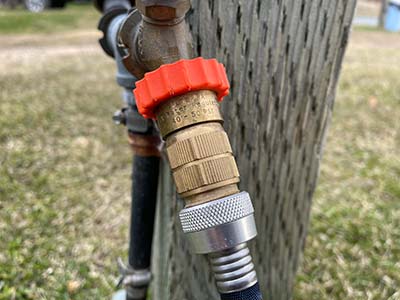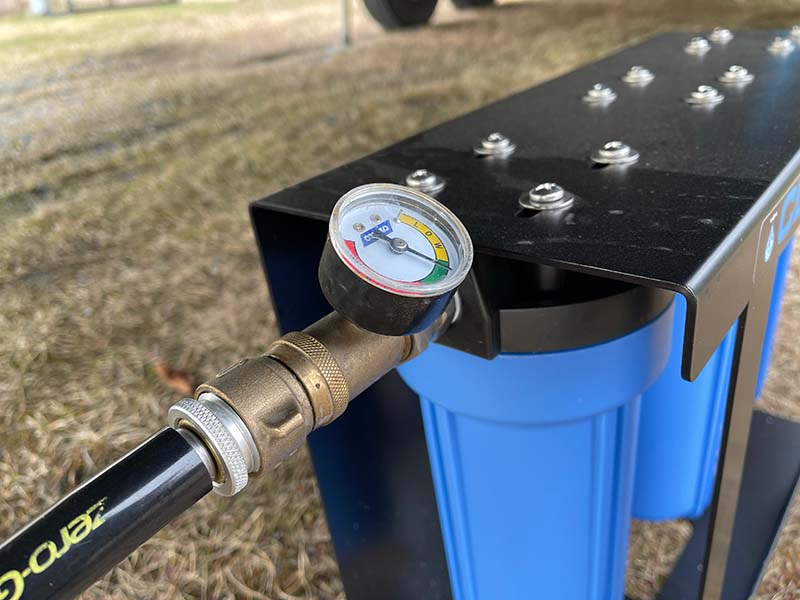Water pressure regulators are a vital component of every RV water system. The ability to control the water pressure entering your RV is necessary to ensure your plumbing is not damaged by high pressure from your water’s source. Properly installed and operated regulators should last for years. While the failure rate of high quality pressure regulators is very low, they can still go bad and fail.
RV Park water pressure can vary greatly. There are many parks and campgrounds around the US that have water pressure high enough to damage your rig’s plumbing. Having a reliable pressure regulator is a must for anyone planning on hooking up to an external water source. I would also recommend carrying a second regulator as a backup.
Whether your pressure regulator is built into your RV plumbing system or part of your external plumbing (in-line hose regulator), I strongly believe every rig needs some way to control the flow of water into the RV or van. All it takes is a little too much pressure, a weak joint in your rig’s plumbing, and you have a potentially expensive nightmare. An interior water leak is an RV’s mortal enemy. If it goes unnoticed, it can cause thousands of dollars worth of damage and can potentially ruin your trip.
Do I need to adjust my PSI or can I set the max at 40?
In most modern RVs, the plumbing can handle water pressure much higher than 40 PSI. I recommend referencing your owner’s manual for recommended water pressure and set your regulator to their recommended pressure. In most cases, 40 PSI is more than enough pressure to meet all your needs inside your rig.
How long does an RV water pressure regulator or PRV last?
Unfortunately, there is no definite time frame I can give you. The harder the regulator has to work (higher pressure), the faster it will go bad. Unless you get a dud, most pressure regulators will last several years. Just make sure you take care of it with routine maintenance every couple months and it will treat you well. I do recommend carrying a backup regulator in your rig in case the one you’re using goes bad. The backup can be the difference between you having running water in your rig and dry camping while waiting for a replacement.
Where is the pressure regulator installed?
There are generally two locations the pressure regulate is installed:
- In-line hose attachment between the water source and your rig.
- Integrated into your rig’s water intake system

Types of RV Water Pressure Regulators
- In-line with gauge. Allows you to visually gauge the pressure and make adjustments.
- In-line without gauge. Without a visual indicator, adjusting the pressure can be tricky.
- Integrated into the RV water system.
How to know if your pressure regulator is failing?
Here are a few signs that it’s starting to fail:
- Fluctuating water pressure
- Odd noises within your rig’s plumbing
- Leaking fixtures
Unchecked water leaks are one of the worst things that can happen in your RV. A small leak can quickly grow and under the right circumstances, cause hundreds or thousands of dollars worth of damage. It’s even possible for an undetected leak to destroy an RV due to mold.
Always carry a backup pressure regulator
Because the water regulator is a vital component in any RV water system, it’s worth carrying a backup in your rig. If your regulator fails, you’ll be able to swap it out without having to scramble to find a replacement. You can carry a simple, cheaper gaugeless in-line regulator as a backup. These typically run about $10-15. Here’s a simple regulator on Amazon made by Camo.
Which RV Water Regulator Valve should I buy?
- Look for lead-free brass – milled red brass is superior to yellow cast brass
- Avoid cheap plastic pressure regulators
- Once you have an idea of what type you want to use, read through online reviews to find one that’s reliable and affordable.
Here are a couple of examples from Amazon:
How to troubleshoot water pressure problems before replacing your regulator
Before spending money on a new regulator, complete these troubleshooting steps to see if it’s a failing regulator or another issue:
- Check the pressure from the water source – if you have low pressure from the source, it’s probably not your regulator.
- Check for a bad hose – look for kinks, cracks, and leaks
- Look to see if the screen or filter built into the regulator is clogged or dirty. Most filters can be cleaned or replaced rather than replacing the entire unit.
- Swap to the backup regulator to see if you still see the same problems
I recommend using a hose made specifically for drinking water like the Camco EvoFlex line from Amazon. It is not prone to kinks or cracks and is very easy to store.
Camco is one of my favorite brands when it comes to regulators and hoses. They have very high ratings and I have not had any problems with their products.
If you’re in a cold environment and need a heated hose, try this 25′ Heated Camo Drinking Water Hose
What tools do you need to install a water pressure regulator?
- Slip-joint pliers
- Plumbing tape
- Non-slip gloves
- A couple absorbent towels to soak up water if working inside your rig
When leaving your rig, turn off the water
This will prevent the nightmare of returning to your rig to see water running out the bottom of the door after a hose or hose connection failed. You can install a simple 45 degree valve to cut off the water from the source to your rig. Better to be safe than sorry. Here’s an example of a shutoff valve from Amazon.
Conclusion
Water pressure regulators are important part of an RV’s water system. The ability to control the water pressure entering your RV is essential to ensure your plumbing is not damaged by high pressure from your water source. Regulators can go bad over time but properly installed and operated regulators should last for years. It’s a good idea to always have a backup just incase you run into a situation where you need to replace your current gauge.

